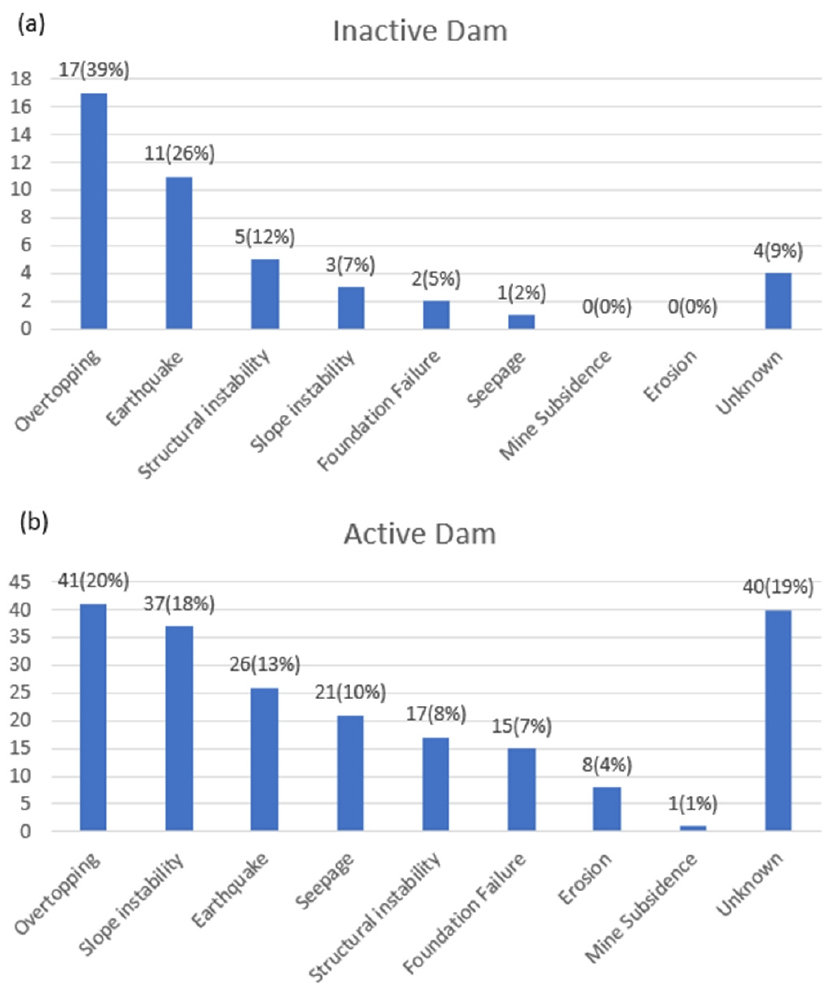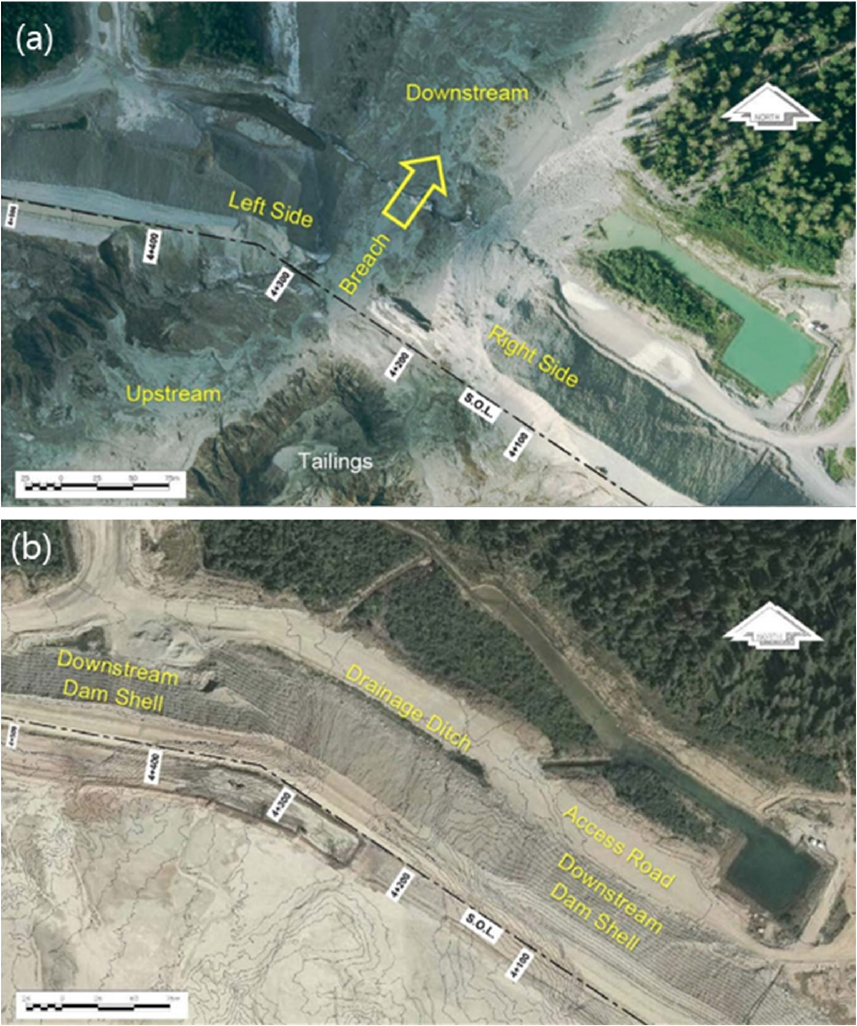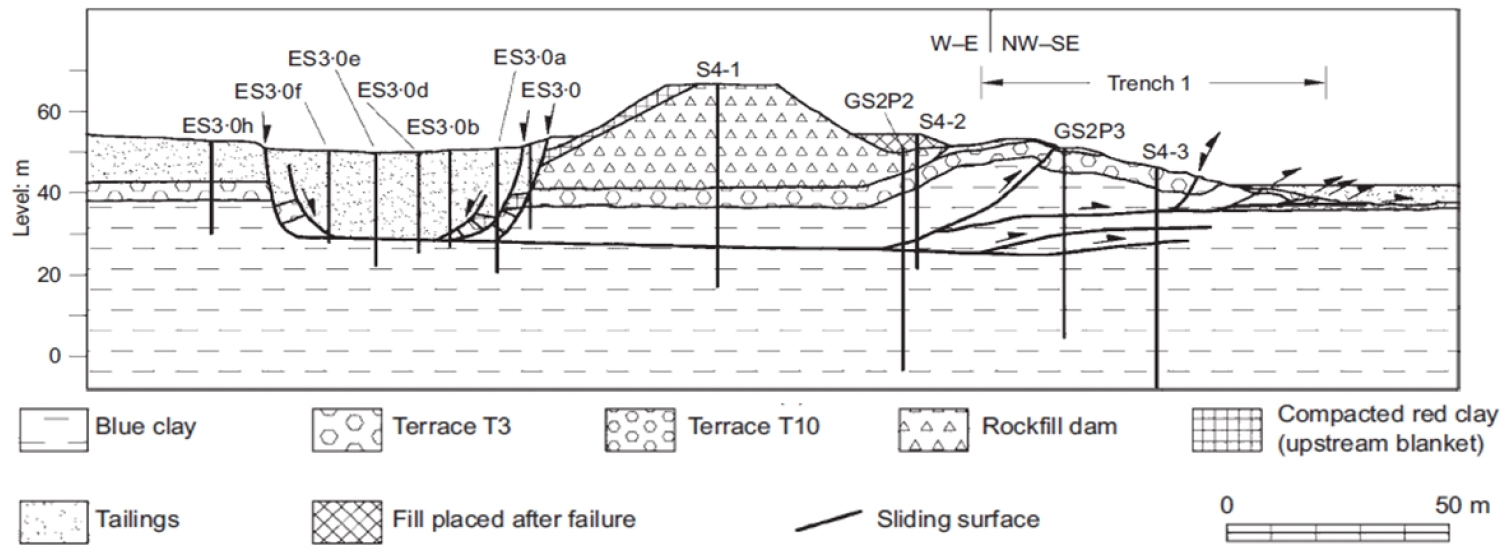서 론
광물찌꺼기 적치장 붕괴 원인
국제 광물찌꺼기 적치장 붕괴 사례
브라질 브루마딩요 광산 광물찌꺼기 적치장 붕괴 (Brumadinho Dam Failure)
캐나다 마운트 폴리 광산 광물찌꺼기 적치장 붕괴(Mount Polley Facility Breach)
브라질 사마르코 광산 광물찌꺼기 적치장 붕괴 (Samarco(Fundão) Dam Failure)
스페인 아즈나꼴라 광산 광물찌꺼기 적치장 붕괴 (Aznacóllar Dam Failure)
남아공 메리스프뤼트 광산 광물찌꺼기 적치장 붕괴(Merriespruit Dam Failure)
호주 카디아 광산 광물찌꺼기 적치장 붕괴(Cadia Dam Failure)
적치장 안정성 영향인자
국제 적치장 관리기준
결 론
서 론
광물찌꺼기 적치장은 유용광물을 추출한 후 남는 물질을 댐 형태로 적치해둔 시설이다. 광물찌꺼기는 주로 암석으로부터 분쇄된 후 물과 섞여 슬라임 형태로 적치된다(Park et al., 2018). 적치장 제체는 암석과 광물찌꺼기의 혼합물로 만들어지는데, 이러한 광물찌꺼기 및 제체의 특성은 안정성에 있어 많은 문제를 야기한다. 최근에는 2014년 캐나다 폴리(Polley) 광물찌꺼기적치장 붕괴, 2015년 브라질 사마르코(Samarco) 광물찌꺼기적치장 붕괴, 2019년 브라질 브루마딩요(Brumadinho) 광물찌꺼기 적치장 붕괴 등 국제적으로 광물찌꺼기 적치장 붕괴 사고들이 잇달아 일어나 막대한 재산상의 피해는 물론 인명피해까지 발생한 바 있다(The Government of British Columbia, 2015; BHP and Vale, 2016; Vale, 2019). 특히, 최근에는 과학잡지 사이언스에서도 광물찌꺼기 적치장의 붕괴 및 광물찌꺼기의 활용에 대한 표지기사를 다루는 등 광물찌꺼기 적치장의 안전한 관리는 국제적인 중요한 주제로 부각되고 있다(Cornwall, 2020).
광물찌꺼기 적치장은 일반적으로 물을 저수하는 댐과 차이를 보이는데, 가장 큰 차이는 저수형 댐은 댐체 완성 후에 물을 채우는 반면 광물찌꺼기 적치장은 시공단계별로 댐체와 광물찌꺼기 적치가 동시에 진행되는 점이다. 이는 저수형 댐과 다른 구조적 불안정성을 촉발시키며, 통계적으로 전통적인 댐보다 붕괴확률이 약 100배 더 크다고 조사된 결과도 있다(ICOLD, 2001). 따라서 광물찌꺼기 적치장의 고유한 붕괴메커니즘에 대한 이해가 중요하다고 할 수 있다(Santamaria et al., 2019).
국내의 경우 광물찌꺼기에 의한 광해발생으로 금속광산의 경우 238개소로 조사된 바 있으며(MIRECO, 2015) 이에 대한 안전한 관리의 필요성이 지속적으로 지적되어 왔다. 국내에서는 박제현 등에 의해 유실 관점에서 광물찌꺼기 특성을 분석한 바 있고(Park et al., 2018) 오삼주 등은 사후관리 표준화를 통한 광물찌꺼기 적치장 평가방법을 제시한 바 있으며(Oh et al., 2017) 정명채 등은 광물찌거기적치장의 안전관리를 위한 적정 모니터링 방안에 대한 모니터링 항목과 캐나다 광업협회의 광물찌꺼기 적치장 관리 사례를 보고한 바 있다(Jung et al., 2018). 하지만 2019년의 브라질 브루마딩요 사례 등 최근의 해외 붕괴사례 등은 소개된 적이 없으며 최근에 제정된 해외의 관리 기준 등에 대한 소개가 필요하다고 생각된다.
본 논문에서는 해외 6개 광산의 광물찌꺼기 적치장의 붕괴사례를 조사하고, 적치장 안전성에 영향을 미치는 인자를 제시하였다. 또한 4종의 해외 광물찌꺼기 적치장 관리기준 분석을 통해 국내 적치장 관리기준 제정 시 활용할 수 있도록 하였다.
광물찌꺼기 적치장 붕괴 원인
전반적인 광물찌꺼기 적치장 붕괴 특성을 파악하기 위하여, 참여과학센터(Center for Science in Public Participation)에 의해 만들어진 1915년 이후 전세계 광물찌꺼기 적치장 붕괴 사고 데이터를 분류하여 Fig. 1에 나타내었다. 이 자료에 따르면, 사면불안정, 누수, 기초, 물넘기, 구조파괴, 지진, 침하, 침식 등이 붕괴원인으로 제시되었다. 적치가 완료되지 않은 적치장이 적치가 완료된 적치장보다 사고건수가 훨씬 많은 것을 확인 할 수 있고, 사고건수를 빈도가 높은 순으로 나열해 보면, 적치가 완료된 적치장의 경우 물넘기-지진-구조파괴-사면불안정-기초파괴-누수순이고 가행 적치장의 경우 물넘기-사면불안정-지진-누수-구조파괴-기초파괴순이다. 비록 원인에 대한 순서가 다소 차이는 있지만, 적치장이 붕괴에 도달한 근본 원인으로는 집중호우, 배수 문제, 지진 등으로 요약할 수 있다.
광물찌꺼기 적치장은 적치방식에 따라 상류축조형(Upstream), 하류축조형(Downstream), 중심선축조형(Centerline), 물 보유축조형(Water retention) 크게 네 종류로 구분된다(Vick, 1983). 이 중 댐 붕괴사례는 상류축조형 적치장이 절대다수를 차지하는데(Park et al., 2018; Rico et al., 2008), 이에 따라 브라질 내 상류축조형 적치방식 금지, 칠레 내 상류축조형 적치방식 금지 등의 적치장 표준에 변화를 주었다(Cornwall, 2020).
국제 광물찌꺼기 적치장 붕괴 사례
본 연구에서 조사된 국제 광물찌꺼기 적치장 붕괴 해외사례를 발생연도, 적치장 높이, 적치방식, 붕괴규모, 붕괴원인 및 사망자수, 가행 여부 기준으로 Table 1에 분류하였다. 해외사례를 위한 문헌은 논문이나 붕괴 후 구성된 조사위원회의 보고서 등을 통해 확보하였다.
Table 1.
Cases of tailings dam failures
브라질 브루마딩요 광산 광물찌꺼기 적치장 붕괴 (Brumadinho Dam Failure)
발레(Vale)사의 브라질 브루마딩요(Brumadinho) 철광산의 광물찌꺼기 적치장 붕괴는 2019년 1월 25일 발생하였으며, 붕괴규모 및 인명피해 면에서 세계 최악의 붕괴사고로 알려져 있다(Vale, 2019). 상류축조형 방식으로 건설된 적치장의 붕괴는 Fig. 2와 같이 중앙부분에서 초기변형 → 하복부 팽창 → 사면파괴 순으로 발생하였다. 사면파괴에 걸린 시간은 10초 미만에 불과하였고, 사상자가 400명(사망 270명)이 넘는 큰 피해가 발생하였다. 이 사고로 적치장 내부 물질의 약 75%에 해당하는 970만 m3이 5분 안에 유실되었다(Vale, 2019).
브루마딩요(Brumadinho) 적치장 붕괴의 원인은 댐체 내부 물질의 액상화이며 이는 곧 사면 불안정성을 야기하였다. 불안정성을 야기한 요인으로는 광물찌꺼기의 취성, 댐체 내부의 배수 부족, 호우에 의한 사면 불포화대의 흡수력(Suction) 감소, 붕괴 전 1년간의 적치장 변위(30~40 mm) 등이 지적된다(Vale, 2019). 흡수력(Suction)의 경우 불포화대의 포화도에 의해 영향을 받으며, 광물찌꺼기의 전단강도를 증가시킨다는 연구가 있다(Zhang et al., 2017). 특히, 브루마딩요 적치장에 사용된 상류축조형 방식은 전세계 적치장 중 약 40%를 차지하나, 붕괴사례로는 75%정도를 차지한다는 보고가 있으며 브루마딩요 적치장 붕괴를 계기로 브라질에서는 상류축조형 방식의 적용을 금지한 바가 있다(Cornwall, 2020).
캐나다 마운트 폴리 광산 광물찌꺼기 적치장 붕괴(Mount Polley Facility Breach)
2014년 8월 4일, 캐나다에 브리티시 컬럼비아(British Columbia) 주에 위치한 금·동 광물찌꺼기 적치장에서 둘레제방(Perimeter Embankment) 기초 하부의 전단파괴로 인하여 Fig. 3과 같이 붕괴가 발생하였다(The Government of British Columbia, 2015). 적치장의 붕괴 전 집중호우로 인하여 적치장 내 수위가 매우 높은 상태였다. 광물찌꺼기 유실은 전조현상 없이 갑작스럽게 발생했으며, 2500만 m3의 광물찌꺼기 및 오염수가 인근 호수로 유입되었고 인명피해는 없었다.
2014년에 추가 건설된 적치장의 댐체는 둘레제방 기초 아래에 위치한 연약한 빙하성 퇴적층의 기초 붕괴를 야기하였다. 빙하성 퇴적층은 적치장 설계 전에 지질 및 시추조사 때 발견되지 않았기 때문에 적치장 시공에 고려되지 않았던 것이 붕괴의 원인으로 지적된다. 적치장의 경사가 원래 설계인 수평 및 수직 비 2:1보다 급하게 1.3:1로 시공된 것이 붕괴원인으로 지목되었다.
브라질 사마르코 광산 광물찌꺼기 적치장 붕괴 (Samarco(Fundão) Dam Failure)
2015년 11월 5일, 브라질 Minas Gerais에 위치한 사마르코(Samarco) 철 광물찌꺼기 적치장의 왼쪽 교대에서 액상화에 의한 붕괴가 발생하였다(BHP and Vale, 2016). 이러한 액상화 거동은 순식간에 발생하였고, 4300만 m3의 광물찌꺼기 및 폐수가 유실되었으며, 19명의 사망자가 발생하였다. 이 적치장은 광물찌꺼기가 쌓여감에 따라 기존 설계와 다르게 건설되었다. 이 차이는 초기 댐체(Starter Dam) 내부 배수관의 손상으로 인한 포화도 증가, 슬라임의 적치 및 물관리 미흡, 왼쪽 교대 하부의 구조적 문제(슬라임 위 댐체의 건설) 등의 문제를 발생시켰다(BHP and Vale, 2016). 이러한 문제들은 곧 사마르코(Samarco) 적치장의 구조적 불안정성을 야기시켰으며, 계속되는 댐체 및 광물찌꺼기의 적치는 슬라임을 압축시켜 적치장이 수평으로 돌출되는 변형을 일으켰다. 이러한 슬라임층은 내부배수가 일어나지 못하도록 하는 차수재 역할을 하여 슬라임 위 모래층을 포화시켰고, 이 모래층은 임계상태에 다다르게 되었다. 또한 2015년 11월 5일 실시된 두 번의 발파와 이에 따라 발생한 세 번의 미소지진은 적치장의 액상화를 촉진하는 요인이 되었다(BHP and Vale, 2016). 액상화에 의한 사마르코(Samarco) 댐의 붕괴는 Fig. 4와 같은 양상으로 발생하였으며, 이러한 붕괴는 위에 언급한 일련의 사건들과 조건들의 연쇄적인 작용에 의한 결과라 볼 수 있다.

Fig. 4
(a) Pre-failure and (b) post-failure photo of Samarco tailings dam (BHP Billiton & Vale S.A., 2016).
스페인 아즈나꼴라 광산 광물찌꺼기 적치장 붕괴 (Aznacóllar Dam Failure)
1998년 4월 25일 남부 스페인 아즈나꼴라(Aznacóllar) 광산의 광물찌꺼기 적치장은 기초하부 지반파괴에 의한 붕괴가 일어났다. 680만 m3의 광물찌꺼기 및 폐수가 유실되었고 인명피해는 없었다. 이 기초 하부에는 높은 소성의 두꺼운 탄산염 불투수성 점토층이 존재하였고, 시간이 지남에 따라 이 점토내 간극수압이 증가하여 유효응력이 감소하였고 결국 전단강도의 감소로 인하여 진행성 파괴가 일어나게 되었다. 이 점토층이 약 60 m 수평방향으로 이동하게 되었고 결국 Fig. 5 및 Fig. 6과 같이 기초파괴에 의한 붕괴가 발생하게 되었다. 설계 전 지질 및 시추조사의 부족으로 댐 하부 연약한 지반을 발견하지 못하고 시공한 점이 큰 문제를 야기하였다(Alonso and Gens, 2006).
남아공 메리스프뤼트 광산 광물찌꺼기 적치장 붕괴(Merriespruit Dam Failure)
1994년 2월 22일, 남아프리카 메리스프뤼트(Merriespruit) 금 광물찌꺼기 적치장의 제방에서 30분간의 30~55 mm의 폭풍우가 내린 이후 몇 시간 후에 붕괴되었다(Fourie et al., 2001). 이러한 액상화 거동은 순식간에 발생하였고, 60만 m3의 광물찌꺼기가 유실되었고 17명의 사망자가 발생하였다. 이 적치장은 광물찌꺼기의 낮은 투수성 때문에 적치장 상부에 호수가 형성되어 있었고, 이러한 조건 때문에 집중호우가 왔을 때 적치장 상부의 물이 넘치게 되어 Fig. 7과 같이 적치장 사면의 선단 침식을 초래하였다. 이는 적치장 하부의 강도 약화로 이어졌고, 적치장 내 광물찌꺼기의 액상화와 결부되어 적치장 붕괴를 일으키게 되었다(Fourie et al., 2001).

Fig. 7
(a) Merriespruit dam failure (Blight, 2009) and (b) plan of Merriespruit tailings dam showing failure (Blight, 2009).
호주 카디아 광산 광물찌꺼기 적치장 붕괴(Cadia Dam Failure)
2018년 3월 9일 호주 카디아(Cadia) 금 광물찌꺼기 적치장은 기초하부 지반파괴에 의한 붕괴가 일어났다(Cadia Valley Operations, 2019). 133만 m3의 광물찌꺼기 및 폐수가 유실되었고 인명피해는 없었다. 이 적치장은 적치장 시공중에 붕괴가 발생한 사례로서, 적치장 사면 안정화를 위한 1차 지지층(buttress) 시공 후 2차 지지층(buttress) 시공을 위한 적치장 사면의 선단부 굴착이 Fig. 8과 같이 기초 아래 연약한 점토층의 진행성 파괴를 일으키게 되었다. 즉, 기초하부 연약층의 존재가 가장 큰 원인이었으며 사면 선단부 굴착, 국부적으로 높은 댐체의 높이(60 m)가 결합된 결과이며 이는 적치장 내 일부 광물찌꺼기의 액상화를 유발하였다(Cadia Valley Operations, 2019).
적치장 안정성 영향인자
해외 적치장 붕괴 사례에 대한 조사결과, 붕괴가 전조현상 없이 급격히 발생하는 경우가 많고, 붕괴로 인하여 액상화된 광물찌꺼기가 빠른 속도로 멀리 흘러 재산·인명·환경에 큰 악영향을 끼쳤다는 점을 알 수 있었다. 무엇보다 적치장 붕괴 발생시 인근에 거주하는 사람들에게 경고할 수 있는 시간이 부족한 경우가 다수였으며, 붕괴 징조는 육안으로 파악하기 힘든 경우 또한 다수였다. 따라서 모니터링 및 체계적인 관리가 필요한 것으로 사료된다. 6건의 해외 적치장의 붕괴 사례를 통하여 Table 2와 같이 기하학적 조건, 지질학적 조건, 침윤선/지하수 높이, 간극수압, 강도, 외부조건 등으로 적치장 안정성에 영향을 끼치는 인자를 도출해 낼 수 있었다. 기하학적으로 적치장 댐체 사면 및 사면선단 조건을 고려해야 하며, 지질학적으로 댐체 내부 혹은 기초하부의 연약층을 고려해야 한다. 또한 침윤선의 높이는 사면의 포화도 및 흡수력에 영향을 끼치는 아주 중요한 요소이다. 이는 곧 댐 제체, 광물찌꺼기, 기초의 간극수압과 직결되며, 광물찌꺼기의 물리적 특성과도 연결된다. 마지막으로 강우조건 및 지진을 포함한 동하중은 적치장 안정성에 매우 큰 영향을 주게 된다.
Table 2.
Factors affecting the stability of tailings dams
국제 적치장 관리기준
현재 광해관리에 관한 국제기준은 국제표준화기구(International organization for Standardization, ISO) 산하의 광업기술위원회 중 하나인 광해관리분과위원회(Mine closure and reclamation management)에서 관리되고 있다(ISO, 2020). 하지만, 광물찌꺼기 적치장의 관리에 대한 국제기준은 아직 지정되어 있지 않고, 개별 국가나, 산업별 협회에서 최근의 광물찌꺼기 적치장 관리의 중요성 증가에 따라 기준을 제시하고 있다. 특히, 이러한 광물찌꺼기 적치장 관리기준은 모니터링과 관리가 연계되어 있기 때문에 중요한 지침이 된다(Clarkson and Williams, 2020). 본 연구에서는 최근에 발간된 총 4개의 국제 적치장 관리기준을 조사하여 Table 3에 정리하였다(Table 3).
Table 3.
Characteristics of guidelines on tailings dams
첫 번째로 호주대형댐위원회(ANCOLD, Australian National Committee on Large Dams)에서 발간한 지침서이다. 이 지침서는 적치장의 안정성 및 물의 적절한 관리에 중점으로 하였다. 광물찌꺼기 적치장 파괴가 사람에게 얼마나 높은 위험성을 보이는지(PAR, Population at Risk), 환경·사회·재산 피해규모를 정하여 결과론적 분류(Consequence Category)를 통해 위해성을 6단계(매우 위험, 위험 상/중/하, 심각한, 낮은, 매우 낮은)로 구분하였다. 6단계로 분류된 위해성을 종합하여 적치장 검사주기, 적치장 안정성 검사 종류 등을 결정하였다. 이 지침서는 재하 조건 및 외부 조건에 따른 적치장에 권장되는 최소 안전율, 연 초과 확률(AEP, Annual Exceedance Probability)과 위해성을 종합한 허용치 등을 제시하였다. 정량적인 평가기준을 만들어 직관적으로 적치장 관리기준을 제시하였다는 장점이 있으나 임계상태(붕괴 직전)에서의 조치사항 등 구체적인 매뉴얼은 부족한 것으로 판단된다(ANCOLD, 2012).
두 번째로 캐나다광업협회(MAC, The Mining Association of Canada)에서 발간한 총 2권의 지침서이다. 이 지침서들은 적치장 시설물 관리시스템 구축에 관한 지침과 적치장 운영, 관리시 위해성 평가, 위해성 관리, 최신 기술(BAT, Best Available Technology) 등과 같은 고려사항들을 목록화하여 현장에서 유용하게 쓰일 수 있게 만든 장점이 있다. 또한, 광물찌꺼기 적치장의 실제 붕괴조짐이 있을 때에 대한 구체적인 매뉴얼이 필요하다는 점에 착안하여 단계별 대응지침(TARP, Trigger Action Response Plan) 개념을 Table 4 및 Fig. 9와 같이 위해성 정도와 결합하여 제시하였다. 그러나 위해성 자체를 정량적으로 제시하지는 않아 실제 임계조건, 그리고 적치장 변형 및 지하수면 변화가 발생하였을 때 위해성을 판단하기 위한 보완이 필요하다(MAC, 2017, 2019).
Table 4.
Example of trigger action response plans with performance indicators related to critical controls, and pre-defined actions for various risk-levels (MAC, 2019)
세 번째로 국제광업금속위원회(ICMM, International Council on Mining and Metals)에서 2020년 8월 발간한 광물찌꺼기 세계산업기준이 있다. 이 기준의 특징은 주제-원칙-필수사항 순으로 지침을 제시하였다. 위해성을 다양한 요소(인명·환경·건강·사회·문화·사회기반시설·경제적 피해)에 따라 분류하고 5단계(극한, 매우 높은, 높은, 심각한, 낮은)로 구분하였다. 또한 캐나다광업협회에서 제시한 단계별 대응지침(TARP, Trigger Action Response Plan)와 실제 임계상태시 취해야 할 조치사항인 응급상황 준비 및 대응지침(EPRP, Emergency Preparedness and Response Plan) 등을 제시하였다. 이 지침서는 ANCOLD와 MAC 지침서들을 종합하여 제시하였다는 장점이 있다(ICMM, 2020).
결 론
본 연구에서는 광물찌꺼기 적치장 붕괴사례에 대하여 조사·분석한 후 적치장 안정성에 영향을 끼치는 인자를 제시하였다. 전반적인 적치장 붕괴 특성을 대량의 데이터들을 분석하여 파악하였으며, 적치장이 붕괴에 도달한 근본 원인을 집중호우, 배수문제, 지진 등으로 요약할 수 있었다. 또한 해외 적치장 붕괴사례 6가지를 분석하여 적치장 붕괴 메커니즘에 대해 정리하였다. 적치장 붕괴 사례 분석 결과, 적치장 붕괴는 전조현상 없이 급격히 일어나고 붕괴징조가 육안으로 파악하기 힘든 경우가 많았다. 적치장 안정성 영향인자는 기하학적 조건, 지질 조건, 지하수면, 간극수압, 강도, 외부조건으로 산정할 수 있었다.
이와 더불어 본 연구에서는 4종의 해외 적치장 관리기준을 조사하여 각각의 특징, 장·단점 등을 도출하였다. 이를 바탕으로 국내에서의 광물찌꺼기 모니터링 및 적치장 관리 방안수립에 활용될 수 있을 것으로 판단된다.











